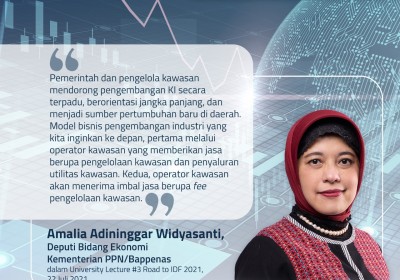Government and Zone Operators Pushing for Integrated Industrial Zone Development
August 03, 2021
JAKARTA – The development of more industrial estates (KI) in Indonesia is part of the government's efforts to stimulate the creation of new growth centers, primarily outside of Java.
Plans to develop KIs that were included in the government's 2015 – 2019 mid-term working plan (RPJMN) were hampered by various obstacles relating to business climate shifts. The first problem was that the completeness and accuracy of basic feasibility studies as well as cost and benefit studies were not carried out properly. Second was the shifting price of global commodities between 2015 and 2019. Third, the readiness of government institutions from the central level to the regional level in implementing such shifts was lackluster and nowhere near the required standards.
The next steps, elaborated within the 2020-2024 RPJMN, was to develop KIs using a more business-driven approach, with help from the private sector. KI development will therefore happen by carefully balancing the objectives of fostering new growth centers with the feasibility of business operations.
According to the Ministry of National Development Planning/Bappenas' deputy for economic affairs Amalia Adininggar Widyasanti, the concept of KI development aligns with the planned direction of Indonesia's industrial development policies, in terms of the plans of business actors (tenants) and also the potential of the products developed (demand driven).
"The development of KIs would be optimal if it is driven by tenants who are able to invest into the zone, and are willing to attract members of the supply chain in their countries to move to our KIs. Also, the government must shape coordinating regulations accordingly for all government institution to help debottlenecking efforts, and place one proper coordinator to oversee all these institutions," Amalia said during the University Lecture #3 Road to Indonesia Development Forum 2021 on Thursday (22/7).
KI development in Indonesia has been going on since the late 1980s and there are currently more than 120 KIs operating and spread across Indonesia with varying development progress, most of it in Java. The private sector has also helped develop KIs as well.
"The government and zone managers are encouraging the development of KIs in an integrated, long-term manner to become a new source of growth for the region. The business model for industrial development that we want in the future involves KI operators providing various zone management and utility facilities, and by doing so will receive a small management fee," Amalia noted.
She added that the key success factors include the availability of infrastructure that will be able to drive competitiveness in the zone.
The government has been active in every phase of KI construction in the country. The extent of their involvement will determine whether a KI will become an efficient place of business or not.
The KI development phase itself is made up of five steps.
First, the government must plan and design the zone by conducting feasibility studies, forging a masterplan, detail engineering designs and establish codes of conduct. Second, the necessary permits must be obtained, be it land use, environmental permit and industrial operation permits. Third is to procure the necessary land through proper procurement and certification processes.
Fourth is to build the zone's infrastructure and necessary public and social facilities, and finally, the fifth step is to invite tenants to rent space in the industrial zone.
Industrial zones that have completed all these steps are deemed ready to accept investments and/or factory relocations from prospective investors, as their land has been procured, infrastructure is in place, permits are sorted and management committed to continue luring investors into the area.
Amalia noted that with such commitment, such as the attitude and process shown at KI Morowali, Indonesian industrial zones are able to attract world-class investment and exude a strong message of industrialization to all.
Indonesia’s Research Institutions Supporting the Development of the Electric Vehicle Industry
Indonesian Muslim Fashion and Cosmetics IKMs Shine at Dubai World Expo 2020
Govt Steps Up UMKM Transformation Efforts in the Midst of Pandemic Slowdown
Govt Encourages Promotion of IKM Products in Digital Era
Government Begins Developing Maritime Training Center in Makassar
Tweets by IDDevForum
